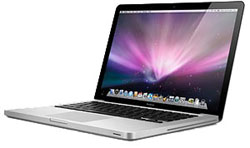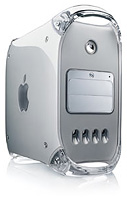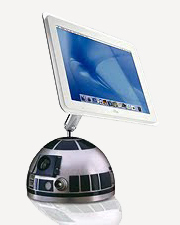The 13″ Non-Retina MacBook Pro Lives On (And On)…
So today was another Apple Event. The iWatch – err, Apple Watch – was finally introduced, along with the 12-inch Retina MacBook and a host of speed bumps. But one small item escaped media attention: the 13-inch MacBook Pro (non-Retina) is still available for purchase, six years after it’s introduction!
 The Unibody form factor debuted in 2008 with the first aluminum MacBook, which replaced the black and white plastic MacBooks. It lasted one generation and did not include FireWire. Soon thereafter Apple moved the Unibody enclosure to the MacBook Pro line, added back the FireWire port, and came out with 13-, 15- and 17-inch versions. These Core 2 Duo based laptops were the last Apple portables to sport optical CD/DVD drives, and removable back panels allow for easy upgrades to the hard drive, RAM and battery.
The Unibody form factor debuted in 2008 with the first aluminum MacBook, which replaced the black and white plastic MacBooks. It lasted one generation and did not include FireWire. Soon thereafter Apple moved the Unibody enclosure to the MacBook Pro line, added back the FireWire port, and came out with 13-, 15- and 17-inch versions. These Core 2 Duo based laptops were the last Apple portables to sport optical CD/DVD drives, and removable back panels allow for easy upgrades to the hard drive, RAM and battery.
An easy-to-service Apple laptop? Clearly this kind of user-friendly design could not be allowed to remain. The 17-inch monster was the first to go, discontinued after the 2011 model. The 15-inch version lasted a year longer, finally retired in 2012 in favor of the Retina MacBook Pro. Retina models have beautiful high-resolution screens and zippy SSDs, but they do not have interchangeable RAM or disk storage, and their batteries are glued in place – not the most serviceable of designs for vintage computing fans.
Meanwhile the 13-inch MacBook Pro remained for sale. The 13-inch Retina version debuted in 2012, with two Thunderbolt ports, long battery life and a speedy SSD. Old reliable remained. By the time Lion and Mountain Lion became mainstream, it was clear hard drives were not optimal any longer for OS X – the phrase “dog shit slow” comes to mind. Lots and lots of beachballs. But people bought it anyway.
Apple is all about smaller and lighter. Today’s 12-inch MacBook is 2.2 pounds, yet the 13″ non-retina MBPro is a backbreaking 4.5 pounds! A CD/DVD drive? So last decade. Why is this system still selling?
 We’ve seen this phenomenon before. In 2003, the PowerMac G4 MDD was upgraded to the FireWire 800 version, which only booted into Mac OS X. Due to user demand for machines that still booted into Mac OS 9, Apple brought back the older dual-boot FireWire 400 version a few months later when the PowerMac G5 was released. This was an online-only purchase, virtually buried on the Apple Store website, yet for almost the next year this model was consistently one of the best selling Mac models. It was repeatedly reported in the company’s quarterly results. Customers knew what they wanted, and Apple was forced to keep selling a model they wanted to retire.
We’ve seen this phenomenon before. In 2003, the PowerMac G4 MDD was upgraded to the FireWire 800 version, which only booted into Mac OS X. Due to user demand for machines that still booted into Mac OS 9, Apple brought back the older dual-boot FireWire 400 version a few months later when the PowerMac G5 was released. This was an online-only purchase, virtually buried on the Apple Store website, yet for almost the next year this model was consistently one of the best selling Mac models. It was repeatedly reported in the company’s quarterly results. Customers knew what they wanted, and Apple was forced to keep selling a model they wanted to retire.
Similarly the Mac mini was virtually an afterthought for Apple. For many years people had asked the company when would they release a sub-$500 Mac. In 2005 they finally did, with the smallest computer they could get away with and an entry price of $499. It was hard to service and the under $500 price didn’t last, but the model sure did. The mini has long been one of Apple’s best selling models, despite a much lower profit margin than those lovely iMacs and Mac Pros. It does the job, is inexpensive and (until the 2014 model) supported upgradeable RAM and hard drives.
The 13-inch non-Retina MacBook Pro is another such model. It may not be a powerhouse, but at $1099 it’s a good value and fully upgradeable. It has Thunderbolt, USB 3, FireWire 800, Ethernet, miniDisplayPort, an SD-card reader – so many ports! Want better performance? Replace the hard drive with an SSD, you’ll be thrilled. It’s easy to add more RAM or replace the battery. For the extra burden of a few more pounds to carry, this system has a far longer service life than the current non-upgradeable, battery-glued-in-place models.
Perhaps Apple customers are smarter than we think after all.


Hello, I am interested in donating a PowerMac G4 “Graphite” to the museum.
Are you interested in collecting it? _R
No, but thank you for the offer.
The Unibody actually started with the first MacBook Air, not with the MacBook Aluminum computer. Its success in the Air made it viable to add to the others in the Apple laptop line.